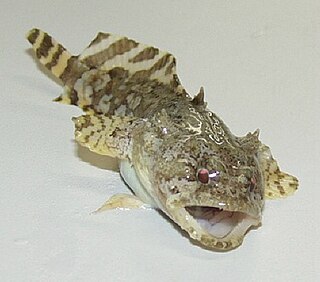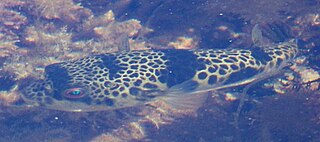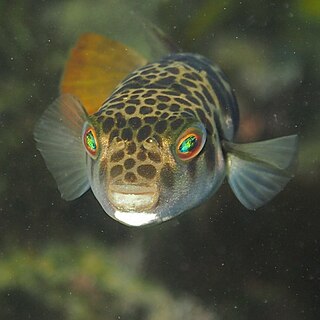
Batrachoididae is the only family in the ray-finned fish order Batrachoidiformes. Members of this family are usually called toadfish, or "frogfish": both the English common name and scientific name refer to their toad-like appearance.

The splendid toadfish also called the coral toadfish and the Cozumel splendid toadfish is a species of toadfish entirely endemic to the island of Cozumel. Commonly found under coral outcroppings. Dens can be spotted by the sloping sand patch. They are very difficult to coax out in the open.
The cotuero toadfish is a species of toadfish found in tropical waters along the Atlantic Coasts of Colombia and Venezuela. This species grows to a length of 30 cm (12 in). It is of minor importance in commercial fisheries.

Batrachoides is a genus of toadfishes.
The whitespotted toadfish is a species of fish in the family Batrachoididae. It is endemic to Belize.
The whitelined toadfish is a species of fish in the family Batrachoididae. It is endemic to Belize. The specific name honours David W. Greenfield and Teresa Arambula Greenfield, who when they collected type specimen though that it might belong to an undescribed species and so sent it to Bruce Baden Collette to be described.
The reticulated toadfish is a species of fish in the family Batrachoididae endemic to Belize.

Torquigener is a genus of pufferfishes native to the Indian and Pacific Oceans. Their name refers to their ability to build circular structures on sandy sea bottom.

Tetractenos is a genus of Tetraodontidae. The genus can be found throughout the Indo-West Pacific and Australia's southern and eastern coastlines.

The smooth toadfish is a species of fish in the pufferfish family Tetraodontidae. It is native to shallow coastal and estuarine waters of southeastern Australia, where it is widespread and abundant. French naturalist Christophe-Paulin de La Poix de Fréminville described the species in 1813, though early records confused it with its close relative, the common toadfish. The two are the only members of the genus Tetractenos after going through several taxonomic changes since discovery.

The Arrecifes de Cozumel National Park is off the coast of the island of Cozumel in the state of Quintana Roo, Mexico. The Cozumel reef system is part of the Mesoamerican Barrier Reef System, the second largest coral reef system in the world. Even though almost the entire island of Cozumel is surrounded by coral reefs, the park only encompasses the reefs on the south side of the island. It begins just south of the International Pier and continues down and around Punta Sur and up just a small portion of the east side of the island. The park contains both shallow and mesophotic coral reefs and extends to the 100 m depth isobar.

The Pacuma toadfish is a species of toadfish found in the Caribbean Sea and Atlantic Ocean along the coasts of Central and South America from Honduras to Brazil. It is the largest toadfish, reaching a length up to 57 cm (22 in) and a maximum recorded weight of 2.3 kg (5.1 lb). This fish is found in local commercial fisheries and the aquarium trade.

The banded toadfish is a species of toadfish found along the Pacific coast of South America where it is found in Chile, Ecuador and Peru. This species grows to a length of 28 centimetres (11 in) TL. It is the only member of the monotypic genus Aphos. Unlike the other genus, Porichthys in this subfamily the banded toadfish lacks photophores.

Colletteichthys is a genus of toadfishes found in the western Indian Ocean. The generic name is a compound of the surname Collette, in honour of the American ichthyologist Bruce Baden Collette to recognise his contribution to the study of toadfish, and the Greek ichthys meaning "fish".

Daector is a genus of toadfishes, with three species found along the Pacific Coast of Central America and two species, D. gerringi and D. quadrizonatus, are found in South American rivers.

The Lusitanian toadfish is a species of toadfish found along the Atlantic and Mediterranean Coasts of western Europe and western Africa, from the Bay of Biscay to Ghana, with an isolated and old northern record from the Norwegian side of the Kattegat. This species grows to a length of 50 centimetres (20 in). This species is of minor importance to local commercial fisheries. Locally, it is known as gripau (Catalan), charroco, encharroco, xarroco (Portuguese), and pez sapo (Spanish)).

Opsanus is a genus of toadfishes found in the western Atlantic Ocean. It currently has six recognised species, with the latest one described in 2005.

Batrachoidinae is a subfamily of toadfish in the family Batrachoididae. It contains 25 species in the following 6 genera:

Thalassophryne maculosa, the Cano toadfish, is a species of toadfish which is common along the Caribbean coasts of South America from Colombia to Trinidad and Venezuela. It occurs on the sandy bottoms of reef flats, lagoons, and seaward edges of reefs where it sits partially buried in the substrate. It is a venomous species with the venom being delivered through spines and wounds from the spines have been known to cause severe symptoms of pain and illness that may persist for up to a week. A study of the holotype of Batrachus uranoscopus, said to be a freshwater toadfish from Madagascar, in the Muséum national d’Histoire Naturelle in Paris found that it was most probably a misslabelled specimen of Thalassophryne maculosa and that subsequent records of Batrachus uranoscopus were attributable to Allenbatrachus meridionalis, a species found in Madagascar. T. maculosa is the type species of the genus Thalassophryne, the generic name translates from Greek as "sea toad" while the specific name is Latin for "spotted".












